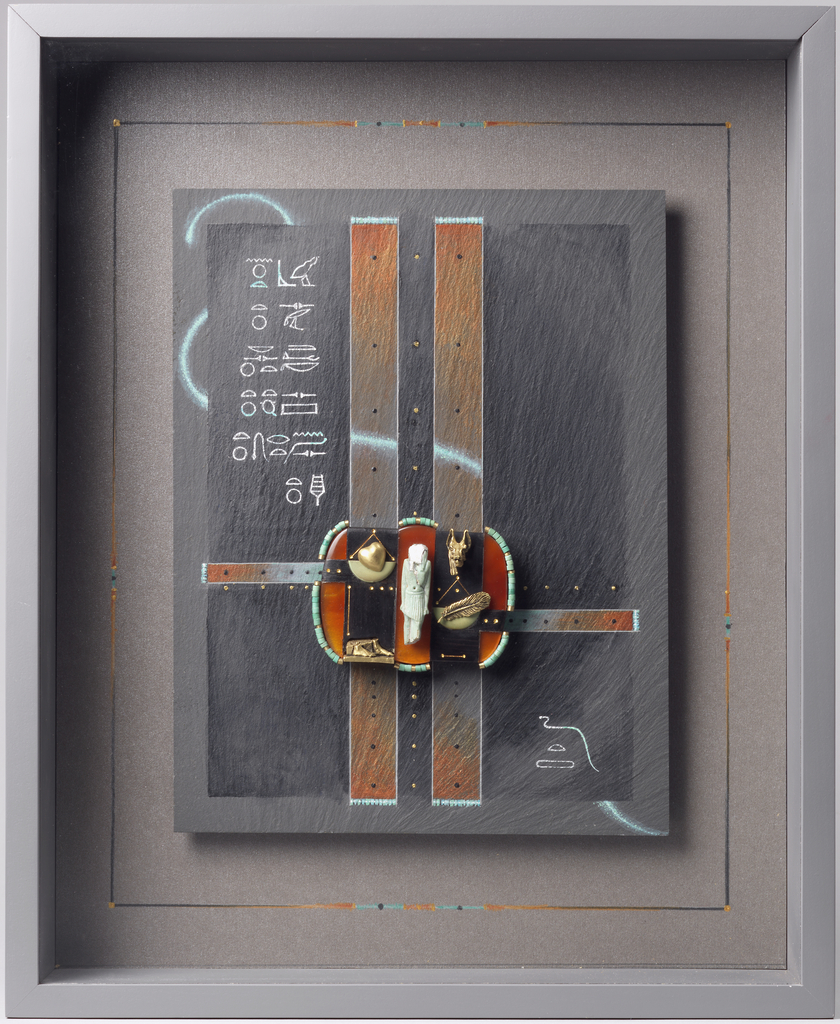There are 2 other images of this object. See our image rights statement.
Object Timeline
|
1993 |
|
|
2003 |
|
|
2011 |
|
|
2015 |
|
|
2024 |
|
The Weighing of the Heart Brooch In Art Form Holder
This is a Brooch in art form holder. It is dated ca. 1998 and we acquired it in 2011. Its medium is gold, faience (ceramic frit amulet fragment, egyptian, 7th-5th century bc), turquoise, carnelian, ebony, silver (brooch); mixed media on slate, joined and painted wood, plexiglass (holder). It is a part of the Product Design and Decorative Arts department.
The Weighing of the Heart brooch, by goldsmith Kevin Coates, was inspired by the Egyptian Book of the Dead, a guide to the soul’s journey through the underworld. According to Coates, “The Anubis amulet which forms the center of my ‘page,’ however, has lost both its hands and feet, but retained, despite its small scale, [a sense] of hieratic monumentality. I was able to recreate the deficient parts in gold, and by creating a divided field of shadow and light (ebony and carnelian), to install them as part of the judgment in which the heart is weighed against a feather (symbol of Maat, justice, and Divine Order).” Coates carries this theme and imagery into the slate mount he created for the brooch—a thought-provoking object of adornment to wear on one’s body or to display in an interior.
Coates is one of England’s leading contemporary goldsmiths. His training began at London’s Central School of Art, and he received his MA from the Royal College of Art in 1976. He is known for his technical virtuosity and his symbolic imagery, which draws from mythology, folklore, mathematics, and music (he is also a noted musician and musicologist). A number of museums and institutions have commissioned or collected his jewelry and metalwork vessels, including the Victoria and Albert Museum, the British Museum, and the Wallace Collection in London; the National Museum of Scotland in Edinburgh; and the Museum of Fine Arts in Boston.
This brooch relates directly to Egyptian antiquities in the museum’s collection. Its stylistic references and hand production techniques also relate to the museum’s collection of work by goldsmiths and jewelers from the Middle Ages through the 19th century. In addition, this piece relates to contemporary jewelry in the collection, such as works by Barbara Natoli Witt, who uses beads and ancient fragments in woven necklace forms.
This object was
donated by
Linda Lichtenberg Kaplan.
It is credited Gift of Linda Lichtenberg Kaplan.
- Egyptian Story Bangle Bracelet
- carved pockwood, cut and polished turquoises and tsavorites, oxidized silver,....
- Gift of Fiona Druckenmiller.
- 2013-27-1
- Digital Print, The Measure(s) of Man, Architect's Data add-on
- digital.
- Courtesy of the designer.
- s-e-1648
- Lotus-shaped Cup (Egypt)
- colored faience (ceramic frit).
- Museum purchase through gift of Eleanor and Sarah Hewitt.
- 1960-29-1
Our curators have highlighted 1 object that are related to this one.
- Necklace
- antique textile, rubber, onyx, nylon, zinc.
- Promised gift to the Susan Grant Lewin Collection, Cooper Hewitt, Smithsonian....
- 7067.113.2016
Its dimensions are
H x W x D: 38.4 × 31.1 × 6.5 cm (15 1/8 × 12 1/4 × 2 9/16 in.)
Cite this object as
The Weighing of the Heart Brooch In Art Form Holder; England; gold, faience (ceramic frit amulet fragment, egyptian, 7th-5th century bc), turquoise, carnelian, ebony, silver (brooch); mixed media on slate, joined and painted wood, plexiglass (holder); H x W x D: 38.4 × 31.1 × 6.5 cm (15 1/8 × 12 1/4 × 2 9/16 in.); Gift of Linda Lichtenberg Kaplan; 2011-15-1




